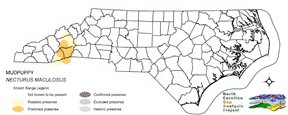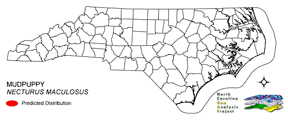
| Taxa: |
| Order: |
| Family: |
| Amphibia |
| Caudata |
| Proteidae |
| NatureServe Global Rank: |
| NatureServe State (NC) Rank: |
| G5 |
| S1 |
| Federal Status: |
| NC State Status: |
| --- |
| SC |


| Land Unit |
| US Fish & Wildlife Service |
| US Forest Service |
| US National Park Service |
| US Department of Defense |
| NC State Parks |
| NC University System |
| NC Wildlife Res. Com. |
| NC Forest Service |
| NC Div. of Coastal Mgmt. |
| Local Governments |
| Non-Governmental Org. |
| Other Public Lands |
| Private Lands |
| GAP Status 1-2 |
| All Protected Lands |
| Statewide |
| Hectares |
| 0.00 |
| 9.63 |
| 0.00 |
| 2.88 |
| 0.00 |
| 0.00 |
| 0.00 |
| 36.06 |
| 0.00 |
| 35.82 |
| 0.54 |
| 0.09 |
| 938.43 |
| 37.59 |
| 84.48 |
| 1,023.45 |
| Acres |
| 0.00 |
| 23.80 |
| 0.00 |
| 7.12 |
| 0.00 |
| 0.00 |
| 0.00 |
| 92.96 |
| 0.00 |
| 88.51 |
| 1.33 |
| 0.22 |
| 2,318.91 |
| 96.74 |
| 212.61 |
| 2,532.85 |
| % of Dist. on |
| Prot. Lands |
| 0.0 % |
| 11.4 % |
| 0.0 % |
| 3.4 % |
| 0.0 % |
| 0.0 % |
| 0.0 % |
| 42.7 % |
| 0.0 % |
| 0.0 % |
| 0.0 % |
| 0.1 % |
| 0.0 % |
| 44.5 % |
| ----- |
| ----- |
| % of Dist. on |
| All Lands |
| 0.0 % |
| 0.9 % |
| 0.0 % |
| 0.3 % |
| 0.0 % |
| 0.0 % |
| 0.0 % |
| 3.5 % |
| 0.0 % |
| 3.5 % |
| < 0.1 % |
| < 0.1 % |
| 91.7 % |
| 3.7 % |
| ----- |
| ----- |
|
In western North Carolina, the species is known from records in the French Broad River drainage but is also suspected to be present in the Little Tennessee drainage (Martof et al. 1980). They can be found in clear or turbid waters of medium and large streams with rocky substrates and in mud-bottomed pond, lakes and other reservoirs (Martof et al. 1980, Petranka 1998). NATURE SERVE GLOBAL HABITAT COMMENTS: Permanent lakes, ponds, impoundments, streams, and rivers of all sorts. Bottom dweller. Often under rock, debris, bank overhang, etc., during daylight. May move into slack water shallows in late fall and early winter. Eggs are attached to undersides of objects in water. May move upstream to spawn (Green and Pauley 1987). NATURE SERVE STATE HABITAT COMMENTS: Large-moderate sized streams. |
| Code | Name | Description | NC Natural Heritage Program Equivalent |
| 238 | Piedmont/Mountain Submerged Aquatic Vegetation | Seasonally to permanently flooded areas with aquatic vegetation. Waterlily, pondweed, hydrilla smartweed are a few of the species that can occur. | Piedmont/Mountain Semipermanent Impoundment (in part) |
| 239 | Piedmont/Mountain Emergent Vegetation | Emergent vegetation of all wetland hydrologies. Sites would commonly support species such as tussock sedge, rushs, and cattail alliances. | Rocky Bar and Shore (in part) |
| 8 | Open water | Open water without aquatic vegetation. | No equivalent |
|
Maxson, L. R., P. E. Moler, and B. W. Mansell. 1988. Albumin evolution in salamanders of the genus NECTURUS. J. Herpetol. 22:231-235.
Petranka, J. W. 1998. Salamanders of the United States and Canada. Washington DC: Smithsonian Inst. Press. Guttman, S. I., et al. 1990. An electrophoretic analysis of NECTURUS from the southeastern United States. J. Herpetol. 24:163-175. Barbour, R. W. 1971. Amphibians and reptiles of Kentucky. Univ. Press of Kentucky, Lexington. x + 334 pp. Minton, S. A., Jr. 1972. Amphibians and reptiles of Indiana. Indiana Academy Science Monographs 3. v + 346 pp. Johnson, T. R. 1977. The amphibians of Missouri. Univ. Kansas Mus. Nat. Hist., Pub. Ed. Ser. 6. ix + 134 pp. Behler, J. L., and F. W. King. 1979. The Audubon Society field guide to North American reptiles and amphibians. Alfred A. Knopf, New York. 719 pp. Martof, B. S., W. M. Palmer, J. R. Bailey, and J. R. Harrison, III. 1980. Amphibians and reptiles of the Carolinas and Virginia. University of North Carolina Press, Chapel Hill, North Carolina. 264 pp. Vogt, R. G. 1981. Natural history of amphibians and reptiles of Wisconsin. Milwaukee Public Museum. 205 pp. Collins, J. T. 1982. Amphibians and reptiles in Kansas. Second edition. Univ. Kansas Mus. Nat. Hist., Pub. Ed. Ser. 8. xiii + 356 pp. DeGraaf, R. M., and D. D. Rudis. 1983. Amphibians and reptiles of New England. Habitats and natural history. Univ. Massachusetts Press. vii + 83 pp. Green, N. B., and T. K. Pauley. 1987. Amphibians and reptiles in West Virginia. University of Pittsburg Press, Pittsburg, Pennsylvania. xi + 241 pp. Cochran, P. A. 1991. Distribution of the mudpuppy, NECTURUS MACULOSUS, in Minnesota in relation to postglacial events. Can. Field-Nat. 105:400-402. Collins, J. T. 1991. Viewpoint:a new taxonomic arrangement for some North American amphibians and reptiles. SSAR Herpetol. Review 22:42-43. |
For more information please contact them at:
NC-GAP Analysis Project
Dept. of Zoology, NCSU
Campus Box 7617
Raleigh, NC 27695-7617
(919) 513-2853
www.basic.ncsu.edu/ncgap